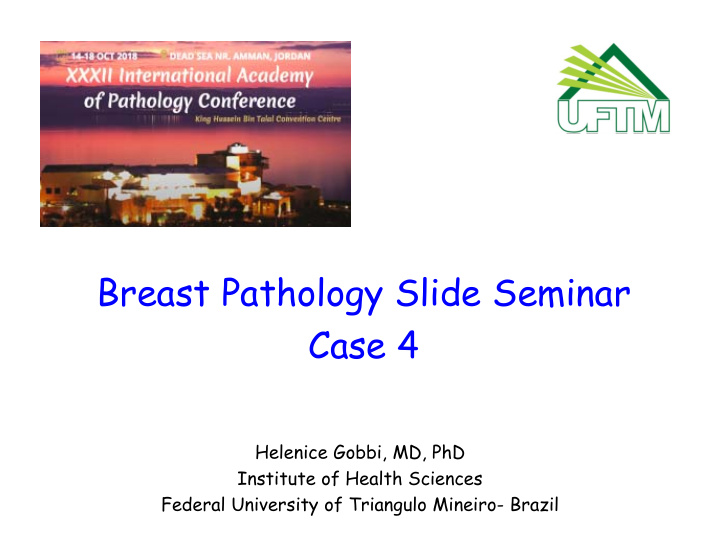



Breast Pathology Slide Seminar Case 4 Helenice Gobbi, MD, PhD Institute of Health Sciences Federal University of Triangulo Mineiro- Brazil
I declare no relevant finantial relantioship
Clinical History • A 73-year-old woman presenting a large ulcerated tumor on her right breast. • Eight years before, this patient had been submitted to a skin biopsy of her right breast that revealed an atypical vascular lesion post-radiation therapy
Previous Clinical History • She had been treated 12 years earlier for invasive mammary carcinoma NST, on her right breast, and invasive lobular carcinoma on the left breast. • She had undergone bilateral breast conserving surgery followed by radiation therapy (Rxt). • She received tamoxifen for 5 years but no chemotherapy. • There was no history of lymphedema in both sides.
Punch Skin biopsy - 4 years after RxT Vascular proliferation present in superficial to mid dermis
Skin biopsy Composed of complex anastomosing and focally dilated vessels
Skin biopsy Chronic inflammatory infiltrate is present, but no evidence of endothelial multilayering, pleomorphism, nucleoli and mytoses
Skin biopsy Dissection of bundles of collagen was focally present
Atypical Vascular Lesion CD-31 The endothelial cells of vascular spaces were positive for CD-31
Atypical Vascular Lesion D2-40 Endothelial cells lining the vascular spaces were positive for D2-40
Atypical Vascular Lesion- Immunohistochemistry for cMYC cMYC Endothelial cells were negative for cMYC
Atypical Vascular Lesion cMYC FISH for cMYC showed no amplification
Diagnosis of skin punch biopsy •Atypical Vascular Lesion, lymphatic type (CD31+ and D2-40+)
8 years after the skin biopsy, 12 years after radiation therapy •Large ulcerated breast tumor
Cut surface: tumor infiltrating skin, dermis and subcutis
Ulcerated breast tumor infiltrating dermis and subcutaneous
Proliferation of cells in solid pattern and few areas of vascular spaces and blood lakes
Dominant proliferation of spindle and epithelioid cells with frequent mitoses
Proliferation of spindle and epithelioid cells in solid pattern and mitoses
Vascular spaces and blood lakes
Nuclear pleomorphism, mitoses, and extravazation of red blood cells and hemosiderin
CD 34 Endothelial cells lining the vascular spaces were positive for CD34
CD 31 Epithelioid cells show strong and diffuse expression for CD 31
cMYC Nuclear cMYC protein expression
High level cMYC gene amplification (red) and CEP8: green
Diagnosis of the breast tumor • High grade angiosarcoma, solid, spindled and epithelioid cell type
Comments • Vascular proliferations of the breast comprise a spectrum of benign and malignant lesions • Atypical vascular lesions (AVL) and secondary angiosarcomas (SAS) are considered part of a spectrum of radiation associated lesions in the breast
Comments • Diagnosis of vascular lesions of the breast may be a challenge in core needle biopsies and punch biopsies: sample not representative of entire lesion • Major challenge is to differentiate: AVL v s low-grade AS High grade epithelioid and solid AS vs other malignancies
Differential Diagnosis of AVL • Differential diagnosis: low grade AS, other benign vascular proliferations (angiomatosis, lymphangiectasia and perilobular hemangioma), and PASH • Extension into subcutaneous fat or breast parenchyma is not a feature of AVL in contrast to low grade angiosarcomas • Some cases may defy definitive categorization Fragua-Guedes et al. Breast Cancer Res Treat 146: 347-54, 2014
Clinical Course and Prognosis of AVL • Natural history and malignant potential of AVL are unknown • Most patients have benign clinical course, but some may recur and patients may develop new lesions • Progression to angiosarcoma is rare (< 1% of reported cases) Fragua-Guedes et al. Breast Cancer Res Treat 146: 347-54, 2014
Differential Diagnosis of High Grade Epithelioid AS • Include: high grade carcinomas, metastatic melanoma, epithelioid sarcomas and large cell non-Hodgkin lymphoma • AS: show variable expression of vascular markers : CD31 (+++), CD34 (+), D2-40 (±) and carcinomas, melanomas and lymphomas are negative • Rare cases of AS are + for CK (AE1/AE3) and EMA • Melanocytic markers: HMB45, melan A, S-100 are positive in melanomas and negative in AS Fragua-Guedes et al. Breast Cancer Res Treat 132: 1081-8, 2012
Ancillary studies in the Diagnosis of AVL and AS Lesion Ki67 IHC markers Molecular studies AVL Low <10% Vascular type: CD31+, No cMYC and CD34+, D2-40 - FLT4 amplification Lymphatic type: CD31+, by FISH CD34±, D2-40+ Both types: cMYC - Primary AS Low grade: > CD31, FL1, ERG, FVIII, Rare c MyC 20% UEA + amplification and High grade: CK± no FLT4 >50% cMYC ± amplification by FISH Secondary Low grade: > CD31, FL1, ERG, FVIII, Frequent c MyC AS 20% UEA + amplification and High grade: CK± , FLT4 ± subset of FLT4 >50% cMYC +++ (diffuse) amplified cases by FISH Fragua-Guedes et al. Breast Cancer Res Treat 151: 131-140, 2015
References
Acknowledgements Giuseppe Viale, MD Conceição M. Fraga-Guedes, MD, PhD Mauro Mastropasqua MD Helenice Gobbi, MD, PhD Rafael Malagoli Rocha, MSc., PhD Saudade André, MD
Recommend
More recommend